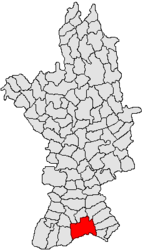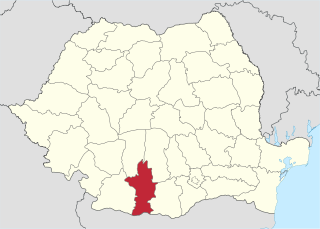
Olt County is a county (județ) of Romania on the border with Bulgaria, in the historical regions of Oltenia and Muntenia. The capital city is Slatina.

Giurgiu is a city in southern Romania. The seat of Giurgiu County, it lies in the historical region of Muntenia. It is situated amongst mud-flats and marshes on the left bank of the Danube facing the Bulgarian city of Ruse on the opposite bank. It is one of six Romanian county seats lying on the Danube river. Three small islands face the city, and a larger one shelters its port, Smarda. The rich grain-growing land to the north is traversed by a railway to Bucharest, the first line opened in Romania, which was built in 1869 and afterwards extended to Smarda. In the past, Giurgiu exported timber, grain, salt and petroleum, and imported coal, iron, and textiles.
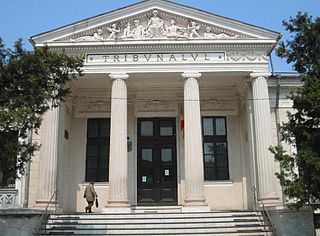
Turnu Măgurele is a city in Teleorman County, Romania, in the historical region of Muntenia. Developed nearby the site once occupied by the medieval port of Turnu, it is situated north-east of the confluence between the Olt River and the Danube, at the edge of the Wallachian Plain.

Târgu Jiu is the capital of Gorj County in the Oltenia region of Romania. It is situated on the Southern Sub-Carpathians, on the banks of the river Jiu. Eight localities are administered by the city: Bârsești, Drăgoieni, Iezureni, Polata, Preajba Mare, Romanești, Slobozia, and Ursați.

Oescus, Palatiolon or Palatiolum was an important ancient city on the Danube river in Roman Moesia. It later became known as Ulpia Oescus. It lay northwest of the modern Bulgarian city of Pleven, near the village of Gigen.

Călimănești, often known as Călimănești-Căciulata, is a town in Vâlcea County, southern Romania. It is situated in the historical region of Oltenia and the northern part of the county, on the traditional route connecting the region to Transylvania, and at the southern end of the Olt River valley crossing the Southern Carpathians.

Pietroasele is a commune in Buzău County, Muntenia, Romania, known for its vineyards. The name means "the rockies". The commune is composed of six villages: Câlțești, Clondiru de Sus, Dara, Pietroasa Mică, Pietroasele and Șarânga. It became famous with the discovery in 1837 of the Pietroasa Treasure composed of several pieces of gold and precious stones. The Romanian historian Alexandru Odobescu wrote a book on the archaeological discovery.

Gigen is a village in northern Bulgaria, part of Gulyantsi Municipality, Pleven Province. It is located near the Danube River, close to the place where the Iskar River empties into it, opposite the Romanian town of Corabia.

Sucidava was a Dacian and Daco-Roman city situated in Corabia, Romania, on the north bank of the Danube. It developed from the 270s AD and especially after the construction of Constantine's Bridge the northern side of which it protected.

Carol I Park is a public park in Bucharest, Romania, named after King Carol I of Romania. A French garden located in the southern-central area of Bucharest, partly on Filaret Hill, originally capable of hosting various exhibitions, it suffered considerable modifications during the communist regime, including a name change to Parcul Libertății.

Traian Ionescu was a Romanian football goalkeeper and coach.

Constantine's Bridge was a Roman bridge over the Danube used to reconquer Dacia. It was completed in 328 AD and remained in use for four decades.

The Moesian Limes is the modern term given to a linked series of Roman forts on the northern frontier of the Roman province of Moesia along the Danube between the Black Sea shore and Pannonia and dating from the 1st century AD. It was the eastern section of the so-called Danubian Limes and protected the Roman provinces of Upper and Lower Moesia south of the river. The eastern section is often called the limes Scythiae minoris as it was located in the late Roman province of Scythia Minor.

Piatra-Olt is a town in Olt County, Oltenia, Romania. The town administers five villages: Bistrița Nouă, Criva de Jos, Criva de Sus, Enoșești and Piatra. The town is an important railway station and road intersection. It officially became a town in 1989, as a result of the Romanian rural systematization program.
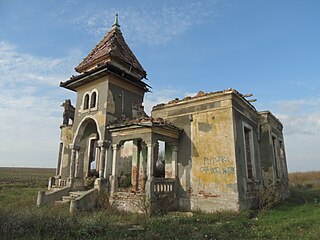
Deveselu is a commune in Olt County, Oltenia, Romania. It is composed of two villages, Comanca and Deveselu.

Fotbal Club Olt Scornicești, commonly known as FC Olt Scornicești, Olt Scornicești or simply as FC Olt, is a Romanian professional football club based in Scornicești, Olt County, currently playing in the Liga IV – Olt County.

Ion Oblemenco was a Romanian football striker who spent the majority of his career playing for Universitatea Craiova. He is known for being four times the top-goalscorer of the Romanian top-division, Divizia A, having a total of 170 goals scored in his 272 appearances in the competition, however these performances were not enough to earn him a cap for the national team.

Acidava (Acidaua) was a Dacian and later Roman town and fort on the Olt river near the lower Danube. The settlement's remains are located in today's Enoşeşti, Olt County, Oltenia, Romania.
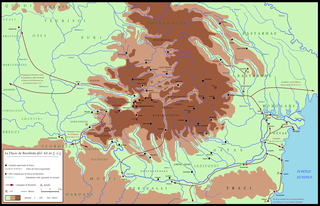
Dava was a Geto-Dacian name for a city, town or fortress. Generally, the name indicated a tribal center or an important settlement, usually fortified. Some of the Dacian settlements and the fortresses employed the Murus Dacicus traditional construction technique.
This is a list of 1991 events that occurred in Romania.

